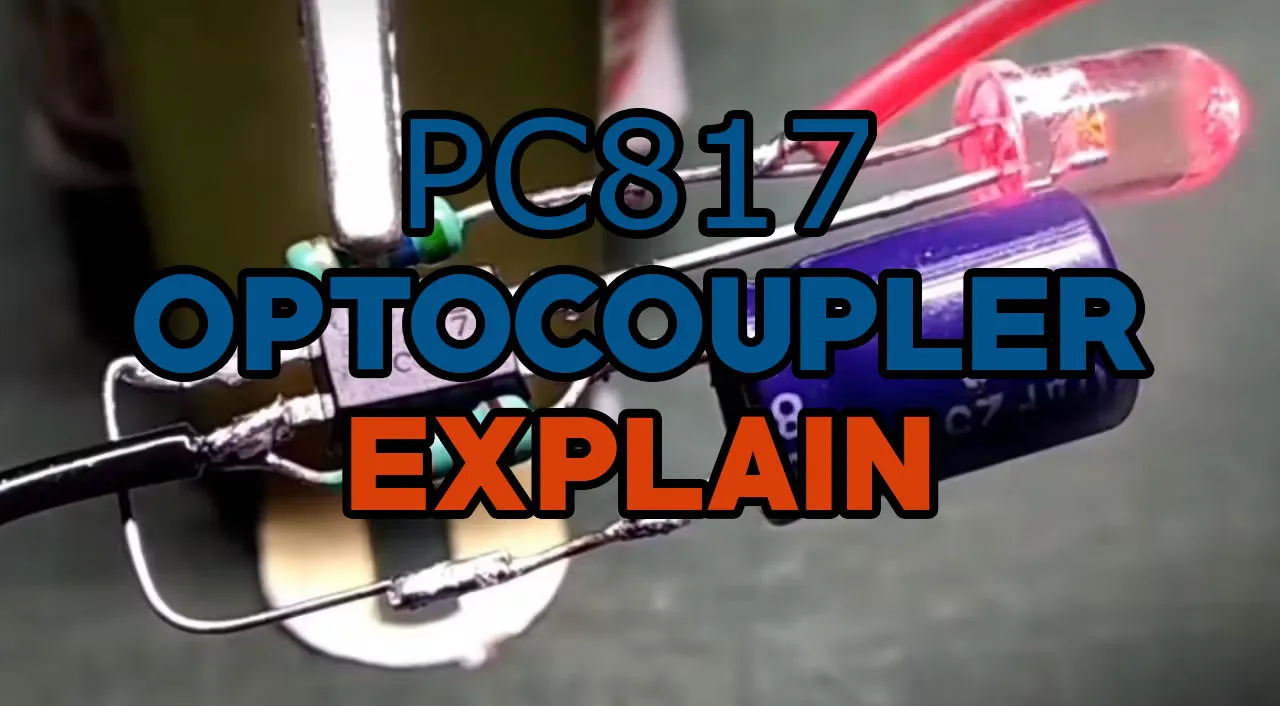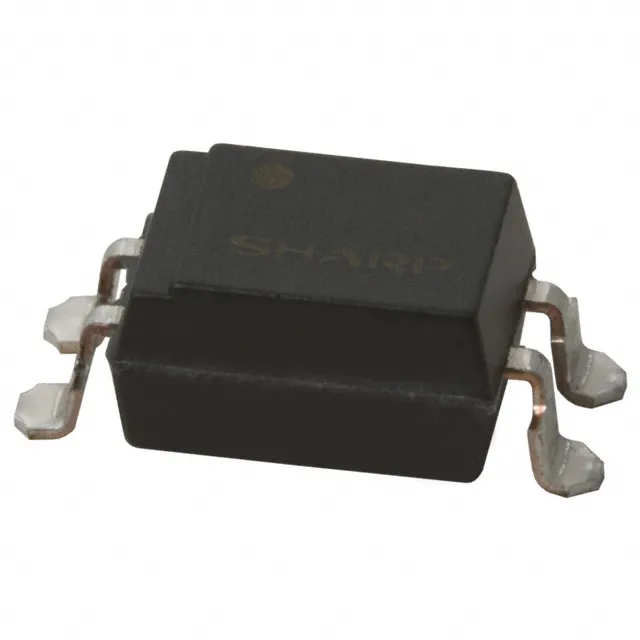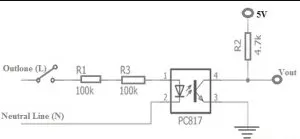PC817 Optocoupler: Working & Its Applications [2024 Updated]

PC817 Optocoupler
Opticouplers, such as the PC817, combine LEDs and phototransistors to make electronic components. Electrical circuits are isolated from each other while still communicating with one another with the help of an isolation resistor. For example, when connecting digital signal lines between two circuits, the PC817 optocoupler is typically used to achieve galvanic isolation.
You will learn everything you need to know about PC817 optocouplers in this guide.
What is a PC817 Optocoupler?

PC817 Optocoupler
Specifically, PC817 IC can be described as a photocoupler, which includes either a transistor or an infrared diode, as we have described above. The purpose of this device is to isolate two circuits electrically from each other. As you can see, the PC817 optocoupler is an inexpensive, four-pin device used for separating signals that can be produced by microcontrollers (for example, a motor drive circuit) from those that can be generated by higher-voltage, higher-current signals (for example, a control signal from the microcontroller).
With a maximum output current of 50mA and an input voltage of 30V, the PC817 optocoupler can handle many different applications. In industrial environments with noise and transients, the PC817 optocoupler is ideal for rejecting noise and transients. In addition, the PC817 optocoupler is suitable for use in extreme environments due to its wide operating temperature range.
How does PC817 Optocoupler work?
Optical coupling connects an infrared LED and a phototransistor to create PC817 optocouplers. Phototransistors detect the light emitted from LEDs when voltage is applied across their terminals, and LEDs emit light when voltage is applied across their terminals.
LEDs illuminate phototransistors, which produce a current when their collector-emitter terminals are connected. It is possible to use this current to trigger other circuits. A phototransistor and LED are connected to the circuit output when an optocoupler is integrated in it.
The LED emits light, which the phototransistor detects and activates the output circuit when the input voltage is applied. A direct electrical connection is not necessary to control the output circuit with the input voltage.
Electrical signals can also be transferred between two circuits without any direct electrical connection by using the PC817 optocoupler. A motor control circuit, a power supply, or an automation system are typical applications for optocouplers.
PC817 Long Run in Circuit: How to Do It Safely
You should always stay below the absolute maximum ratings when using PC817 optocouplers in your circuit. To ensure that the IR LED can't be driven more than 50mA, a current limiting resistor should be placed on pin1 of the optocoupler. As with any other LED, the internal IR LED can be driven like any other LED. Make sure the device is kept at a temperature of no lower than -55 degrees Celsius and no higher than 125 degrees Celsius, and only operate it at temperatures no lower than -30 degrees Celsius and no higher than 100 degrees Celsius.
PC817 Optocoupler Applications
Optocouplers, also known as optoisolators, are versatile electronic components that are typically used to isolate inputs from outputs in various applications. The PC817 optocoupler can be used in the following applications:
Switching Power Supplies: Typically, PC817 optocouplers are used to isolate the control circuitry from high-voltage output circuits in switching power supplies. A voltage spike or noise can adversely affect sensitive control components this way, improving safety and reliability.
Isolated Signal Transmission: PC817 optocouplers are used in industrial control systems to maintain electrical isolation while transmitting signals. To prevent ground loops and signal interference, this technique is particularly useful in noisy environments.
Motor Control: PC817 optocouplers can serve as a link between low-voltage motor drivers and low-voltage control signals in logic circuits and microcontrollers. Using such a protection method ensures safety and prevents voltage surges or transients from damaging sensitive control electronics.
Isolated Interface for Microcontrollers: An optocoupler PC817 connects a microcontroller to an external device, such as a relay, a triac, or a solid-state switch. A voltage spike or electrical noise can damage a microcontroller if they are not isolated from the external device.
Signal Isolation in Audio Equipment: It is possible to isolate audio signals from control circuits with PC817 optocouplers used in audio equipment, such as amplifiers or mixers. As a result of this, ground loops are prevented and interference and noise are reduced.
Medical Devices: Electrical isolation is a critical safety factor in medical devices using PC817 optocouplers. Signals are transmitted between different parts of the system safely and accurately with the help of such devices as patient monitors, infusion pumps, and defibrillators.
Isolated Data Communication: When there is a risk of electrical interference between devices or voltage differences between them, it is important to isolate the data lines. Data communication systems use the PC817 optocoupler for establishing communication.
Battery Management Systems: To ensure safety and prevent damage to control electronics, PC817 optocouplers can be used in battery management systems for electric vehicles or renewable energy systems.
PC817 IC Optocoupler Circuit
The PC817 Optocoupler circuit diagram is shown in the following. A DC circuit is switched by an IC such as PC817 in this circuit. The above optocoupler circuit uses a photo transistor as a switch, which works the same way as a transistor. Using an optocoupler-based phototransistor, this circuit offers low cost and high efficiency. Switch 'S1' can be used to control an IR LED.

Circuit Diagram
A 9V battery is used to power the LED when the switch is activated using the 10K resistor. With the resistor 'R1', you can control the LED's intensity. The transistor gain will be high if we modify the resistance value to a smaller value.
An IR LED is used to control the phototransistor on the other side of the circuit. A phototransistor will make contact once the LED emits infrared light, and its output voltage will be zero, thereby turning off the load beyond.
Keeping in mind that the transistor's collector current equals 50mA according to the PC817 IC datasheet is very important. R2, which is pulled up here, provides the 5V output voltage for the power supply. A microcontroller is used in this circuit design to detect pulses otherwise interrupted by an optocoupler based on a phototransistor.
PC817 optocouplers work extremely well, but they also have different specifications depending on which device they are used with. Logic output pins need to be fixed through the power pin at the output of the optocoupler, while the input pin needs a current limiting resistor. Infrared signals will lead to a logic condition change, which is a change within the current flow from one to zero when infrared signals are generated.
PC817 Optocoupler Features
PC817 optocouplers, also known as optoisolators, are commonly used to transmit signals and isolate electrical signals in electronic circuits. The following are some of its key characteristics:
Optical Isolation: LEDs (light-emitting diodes) and photodetectors (usually phototransistors or photodiodes) make up the PC817 optocoupler. Transmission of optical signals between the input and output circuits provides electrical isolation.
Small Size: It is possible to use PC817 optocouplers in compact packages on circuit boards with densely populated areas and applications that are space-constrained.
Low Power Consumption: Low drive currents result in minimal power consumption for LEDs used in the PC817. Devices that run on batteries and are designed to use less energy benefit from this feature.
High Isolation Voltage: Input and output voltages between the PC817 optocouplers are not impacted, providing wide isolation voltage ratings.
Adaptable to varying temperatures: Optocouplers of this type are designed for use in environments that can experience varying temperatures due to their wide operating temperature range.
Fast Response Time: Input and output signals can be transmitted rapidly between PC817 optocouplers due to their fast switching speeds. Applications that require fast response times need this feature.
Versatility: In addition to switching voltages, signal isolators, and level shifters, PC817 optocouplers are versatile components. Analog and digital signals can be processed with them.
Reliability: Electronic systems are durable and long-lasting thanks to PC817 optocouplers' robust design and high-quality construction.
Wide Range of Applications: The versatile operation of PC817 optocouplers makes them appealing for applications in a wide range of fields, including industrial automation, telecommunications, medical devices, automotive electronics, and consumer electronics.
Cost-Effective: Electronic circuits can be electrically isolated with PC817 optocouplers more economically than with transformers or digital isolators. A wide range of applications can be served by them due to their affordability.
Faqs
Question 1: What are the typical applications of PC817 optocouplers?
Answer: Among the many fields in which PC817 optocouplers are used are industrial automation, telecommunications, medical devices, automotive electronics, and consumer electronics. Noise immunity, signal isolation, level shifting, and voltage-controlled switching are just some of the tasks they perform.
Question 2: What is the maximum isolation voltage of a PC817 optocoupler?
Answer: It depends on the manufacturer and model of the PC817 optocoupler what the maximum isolation voltage is. Normally, isolation voltages of several hundred to several kilovolts are used to ensure the safe operation of high-voltage equipment.
Question 3: Are PC817 optocouplers polarity sensitive?
Answer: There is no polarity sensitivity associated with PC817 optocouplers. Their operation is not affected by the direction in which they are connected. For the input and output circuits to be properly connected, however, the pinout configuration should be carefully considered.
Final Verdict
The PC817 optocoupler is used to transmit and isolate electrical signals in electronic circuits. In addition to being reliable, they are versatile as well. The PC817 offers a wide range of benefits suitable for diverse applications across a wide range of industries with its compact size, low power consumption, and fast response time.
PC817 optocouplers provide electrical isolation for sensitive components in high-voltage environments. The unique characteristics of the device make it a vital component in industries such as automotive electronics, telecommunications, and medical devices.
PC817 optocouplers have a versatile design that allows them to be used in isolation circuits, level shifting circuits, as well as noise immunity circuits. Further contributing to its widespread adoption in electronic design is its reliability, affordability, and ease of use.
To summarize, the PC817 optocoupler is an extremely useful component for designers and engineers seeking reliable solutions for electrical isolation and signal transmission in their electronic systems. This product provides efficiency and reliability across a wide range of applications due to its combination of features, performance, and versatility.
Why Using Op Amps as Comparators?
How does the Oscilloscope's X-Y Display Work ?
Operation & Fault Handling of High Voltage Switchgear Explained
How Long Do Electrolytic Capacitors Last [Explained]
How to Install a Capacitor to Two Amps
NPN VS PNP BJT Transistor: Common Knowledge
The Ultimate Guide to CR1220 Battery
The Automotive PCB Market Seizes Fresh Opportunities
Difference Between Isolator and Circulator? [Guide]
Difference Between Serial and Parallel Communication










